Vintage_Mania
1979 Honda CB400T
One day I was going through a bunch of really old magazines and literature with a friend. He kept saying things like: "Whoa! What's that? I never heard of it." Or: "Man, that is one strange-looking bike!" Or: "Jeez, that is incredibly ugly and more-than-bizarre!"
So I gathered up a bunch of them and figured I'd share them with you. As long as you're looking at these weird old bikes, take a casual test and see how many you recognize. If you get about half, that means you've been in the sport a long time, and qualify as a "dirt bike historian" yourself.
Have fun!
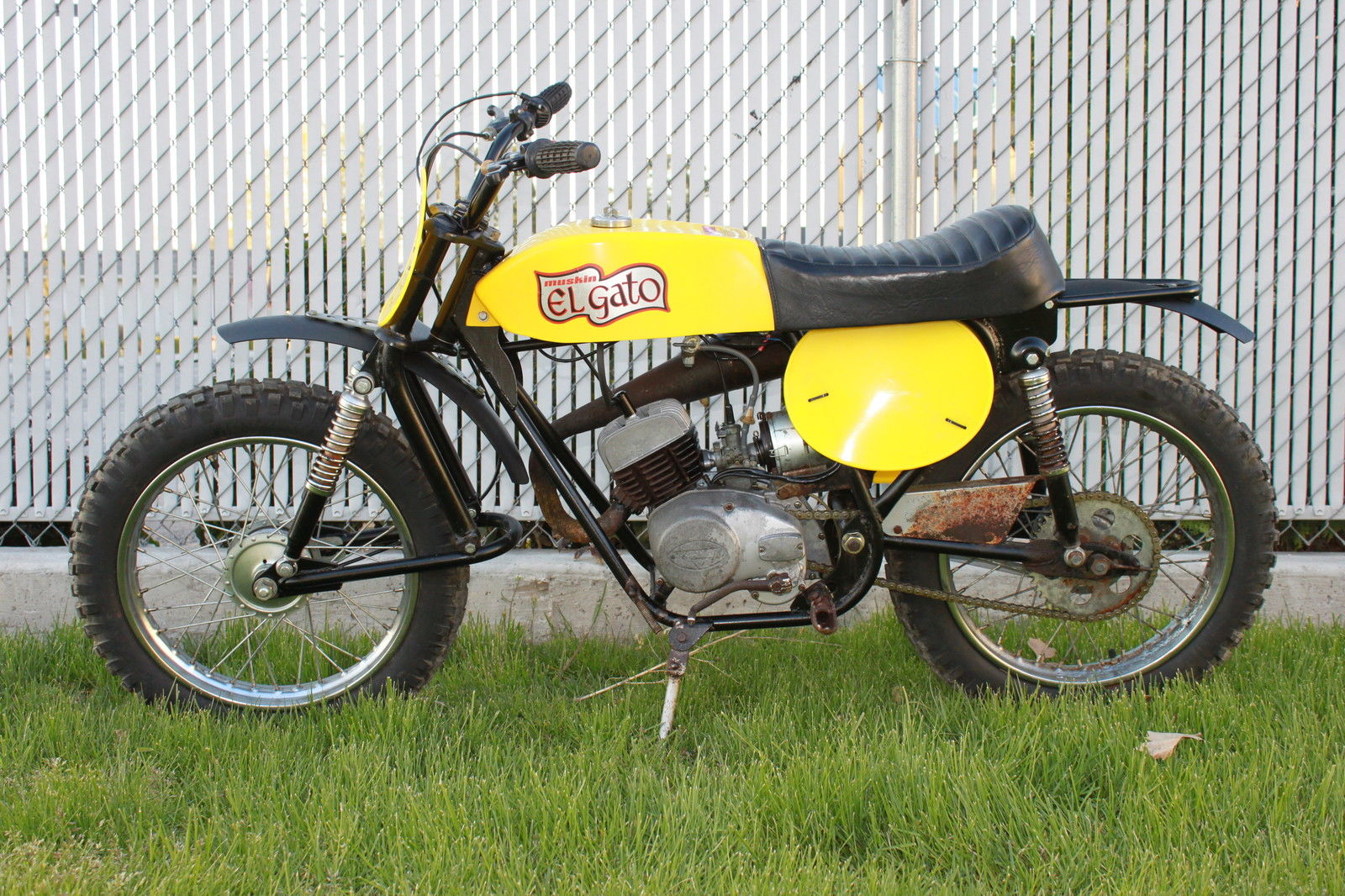
EL GATO ALL-FAMILY MIDI-CYCLE
An odd-looking little bike, El Gato (Spanish for "the Cat") claimed it was not a mini-bike, but a midi-bike, whatever that is. Like many bikes of the very early '70s, it used a Fuji engine, the fore-runner of the Hodaka. Here's what the company had to say about El Gato in their advertising literature:
The Muskin Corp. is introducing El Gato, a thoroughly tested all-family midi-cycle. Powered by an 80cc Fuji two-stroke, single-cylinder engine, the bike delivers 6.6 hp, has a four-speed, constant-mesh transmission and curb weight of 125 pounds. Well balanced on a 44-inch wheelbase, El Gato's overall length is 67 inches with seat height of 27 inches. The 3.00 x 16 knobby tires give maximum traction. The machine's seat-tank combination is finished in chrome yellow. Leading link front and swing arm rear suspension, front and rear internal expanding 105mm brakes, noise emission-approved spark arrester exhaust, flexible fenders and folding footpegs complete the package.

FANTIC CABALLERO 125RC
This neat small-bore enduro bike was powered by an Italian Minarelli engine and did quite well in European events. It saw some action in the early 1980's and a small number were sold in Europe.
Engine: Single-cylinder two-stroke, with piston-port induction
Capacity: 124cc (55.2 x 52mm)
Compression ratio: 14:1
Carburetion: 32mm Dell Orto with enrichening circuit for cold starting, breathing through oil-soaked foam filter
Claimed maximum power: 26bhp at 10,500rpm
Lubrication: P11 Goldfire at 40:1
Transmission: Primary drive by gears to six-speed gearbox. Wet clutch
Electrical equipment: 55-watt Motoplat generator with pointless ignition and 6-volt DC lighting
Fuel capacity: 8 litres (1.75 imp gal) (including reserve)
Suspension: Marzocchi leading axle front forks giving l0 inches of travel.
Twin damper swinging arm controlled by Sachs Hydracross units giving 11 inches of travel at the rear wheel
Frame: Full duplex
Tires: 3.00 x 21 in. front; 4.50 x l8in rear, both Metzeler motocross/enduro
Brakes: 6 inch s.l.s. by Grimeca front and rear
Wheelbase: 58in
Ground clearance: 12 in.
Saddle height: 35 in.
Claimed dry weight: 209 lbs.
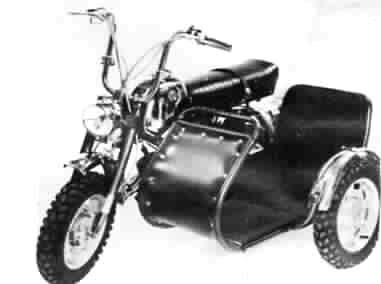
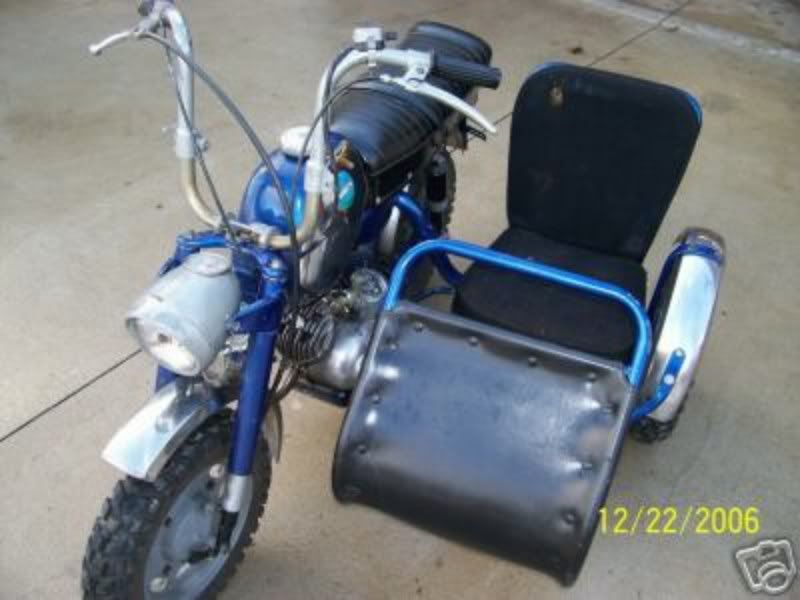
BENELLI MIDI-SIDEHACK
A whole slew of mini bikes came out of Italy, but this one might just be the most bizarre. For some reason, it never caught on with anyone. Here's what Cosmo Motors, the distributors, had to say about this ... thing! Cosmopolitan Motors has made available the world's first "midi-sidecar," powered by the 65cc four-speed Dynamo series of midi-bikes. The sidecar features a 10-inch steel wheel and knobby tire, stainless steel fender, plush velour upholstered seat, leg cowling and a hand rail. Though firmly affixed to the Dynamo frame, the sidecar can be easily removed for servicing or solo riding.

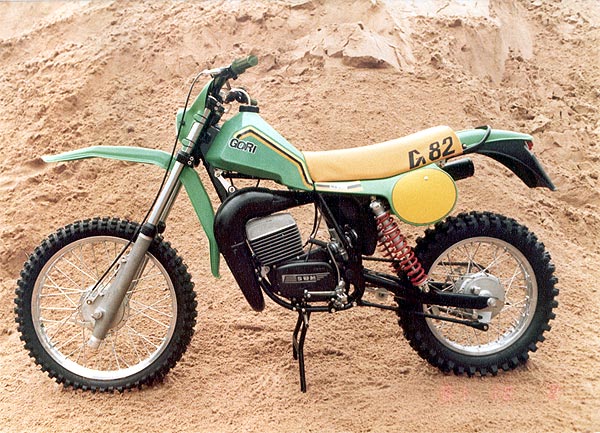
MOTO-GORI TR250
The Austrian engine builder, Rotax, sold motors to a whole bunch of companies who made just a frame, bought all the other components, and slapped their name on the tank. This one was built in 1980.
Engine: SWM/Rotax single-cylinder two-stroke with disc-valve induction
Capacity: 248.23cc (72 x 61mm)
Compression ratio: 14:1
Claimed power: 38 bhp at 8500rpm
Carburetion: 32mm Dell Orto
Foam filter
Transmission: Five-speed with ratios to rider's choice.
Primary kickstarting with wet plate clutch
Ignition: Motoplat CDI with 55W generator. 6V DC lighting system
Fuel capacity: 12.7 litres (2.8 imp gal)
Frame: Single backbone with duplex engine cradle and twin shock
swinging arm
Tires: 3.00 x 2lin front; 4.50 x l8in rear. Metzeler motocross/enduro
Suspension: Samfis front forks with 12.4in of travel. Rear, Bitubo
dampers with external reservoir ... 11.8 in of travel
Brakes: Front, Grimeca 5 in; Rear, fully floating Grimeca, 5 in
Wheelbase: 50.2 in
Saddle height: 36.4 in
Ground clearance: l4 in
Dry weight: 224 1bs


SPEEDWAY SUPER SPYDER
This tiny and spindly-looking little bike came with a whopping 125 cc Sachs engine, which made for a lot of power in not much of a chassis. Still, the makers bragged up it highly in their 1970's ads:
On the trail, leave the others looking at the tailpipe of your Super Spyder. If your bag is winning, go with the name that consistently wins -- Speedway. Our bag is making top performance machines. To prove it, check out the "maximum mini" - the Speedway Super Spyder. Its 125cc Sachs engine, kick start, and five- speed synchronized foot-operated gears make you feel you're riding one of the big bikes.
All things considered, I never heard of a Super Spyder winning any race, anywhere. By the way, Speedway also offered other models with fancy names, like the Scorpion and the more-than-aptly-named Widowmaker.

Not too sure if you like boys or girls, or both? Then this Bi-Car should fit the bill nicely. Here's more info from the makers in the year 1972:
Traditionalists may flinch, but here's a totally new concept in two-wheeled touring vehicles. And adventurous souls just might find that "something different" they're looking for in the Bi-Car. Eight years of research and development have gone into the Bi-Car, so it's no spur-of-the-moment idea. Bell Vehicle, Inc., IS serious about the project, and has even more expansive plans for the future. The vehicle seats two passengers in tandem and utilizes standard motorcycle controls. At lower speeds and when stopping, the Bi-Car features a retractable landing gear that comes down to stabilize the machine. In addition to a sturdy, close-fitting shell, an optional canopy offers protection from dust, rain, noise and wind. Shown is the Saturn 500 model; it's 9 feet, 10 inches long, 33 inches wide and weighs 470 pounds. Powered by a 500cc, 60-hp engine that gets up to 40 mpg, Saturn models are in production and sell from $1590 up.

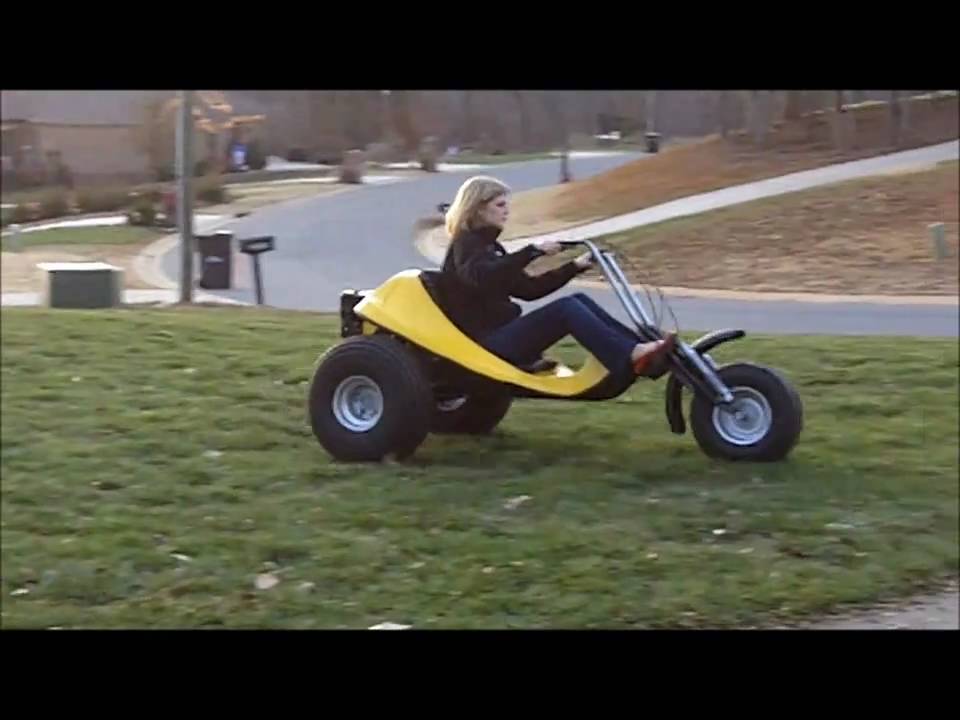
SPORTY SNOWCO TRI-SCAT
What a sad name for this 1972 three-wheeler. "Scat?" Isn't that slang for ... well ... never mind. Three ways to "dump" it? Anyway, the makers were proud enough of this no-suspension device to write some glowing copy:
The Snowco line of three-wheel vehicles offers utility as well as sport. And a front ski attachment which replaces the front wheel permits year-around use. Sportiest is the Tri-Scat with metalflake fiberglass body (shown), leather-type bucket seat, and low-bar, low-pressure ATV tires. It's available with 5-hp or 7-hp engine, and the 7-hp model comes equipped with standard head lamp and roll bar. The 7-hp Tri-Scat is also available in a deluxe model with 12-V key starter, head- and taillights, chrome front fork, roll bar and hubcaps. More utilitarian is the Nomad, also available with 5-hp or 7-hp engine, and equipped with wide, low-pressure knobby tires. Headlight and roll bar are standard on the 7-hp model. Addition of an optional cargo carrier makes the machine a utility vehicle for hunters, fishermen, farmers and many other users. The "baby" of the line is the 2 1/2-hp Mini-Scat, produced especially for youngsters, but far from a toy.

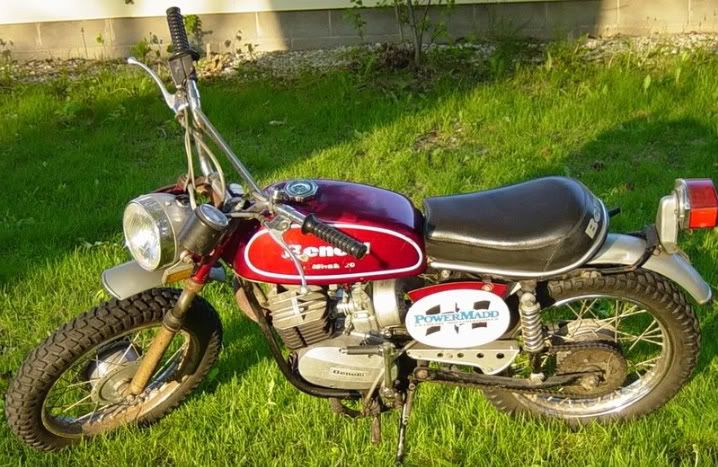
BENELLI BANSHEE
Yet another midi-cycle from Benelli. I'm still puzzled as to that midi-cycle name that was used only for a few years in the '70s. Looks pretty much like a mini-cycle to me. Either way, this was their enduro model and among other claims, they figured it was ready for the roughest terrain:
Benelli's new midi-cycle is styled after their well known Mini-Enduro. The Banshee has an all-new 90cc, five-speed two-stroke engine. Pirelli moto-cross tires (2.75 x 15") and enduro suspension smooth out the toughest terrain. Full electrics, battery, and a 44-inch wheelbase make the Banshee street-legal. Other features include an upswept exhaust, skid plate, Dell'Orto concentric carburetor, radial cylinder head finning, and performance that will embarrass many 125's.
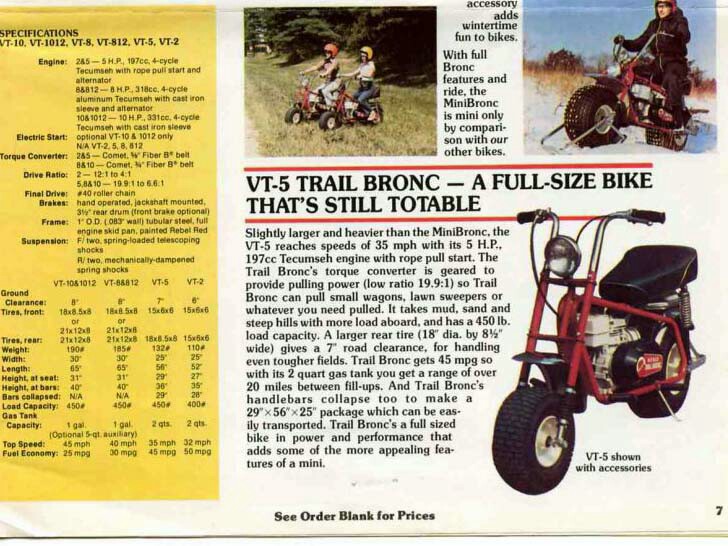
Want to build your own ill-handling, no-suspension mini bike? Well, you could in 1972, if you coughed up a few hundred bucks. Here's how:
ALL-TERRAIN TRAIL BIKE KIT - Heald, Inc., is now marketing a new Trail Bronc, model VT-3. Company officials state that the VT-3 has been improved in performance, reliability and riding comfort over previous models. Powered by a 172cc Tecumseh engine, the new Trail Bronc utilizes a sensitive torque converter transmission and heavy-duty No. 40 chain in the final drive. A big 8 ? inch wide rear tire and 6 1/2-inch wide front tire provide the traction and stability needed on the trail. Their low pressure design coupled with the telescoping front shocks, damped coil spring rear shocks and large - padded seat smooth out the rough spots encountered in trail riding. The 8-inch ground clearance and engine skidpan enable the bike to go over almost any obstacle. Full steel fenders both front and rear (decorated with a sporty racing stripe) serve to keep mud and dirt off both bike and rider. There are just two simple controls, a hand-operated brake lever and safe spring return twistgrip throttle. A stop button is also mounted on the chrome plated handlebars. The handlebars telescope down for easier transport and storage. The bike can be ordered with alternator engine for powering the optional road approved lighting accessory. A front ski is also available so the machine can be used the year around. This rugged bike is ideal for hunting, fishing, camping, farm and ranch, work or play. The Trail Bronc comes in money-saving, easy-to-assemble kit form.
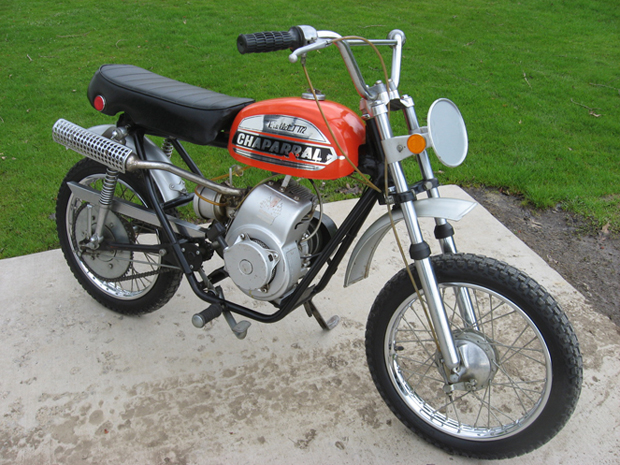
CHAPARRAL "FAMILYWEIGHT" MINI-CYCLES
What happens when a '70s snowmobile company wants to get in on the dirt bike boom? Well, they build a carbon-copy of just about every other below-average mini-cycle ever made in that time frame. But they seemed proud of their effort, as the copy below illustrates:
Chaparral Industries, fastest growing major snowmobile company in the country, has recently added mini-cycles to its product line. The bikes will be available in three models: the Bullet ST80 (shown), the Bullet T80, and the Bullet T172. Built primarily for trail riding, the ST80 and T80 are four-speed bikes powered by a two-stroke, 80cc Fuji engine that pumps out 7.5 hp at 6800 rpm. The T172 has a 172cc Tecumseh four-stroke powerplant and torque-converter for shift-free riding. Top-of-the-line ST80 weighs 125 pounds, has hydraulic front suspension with rear coil springs. On this model, lights, horn and speedo package are standard. Trail-ready T80 version is stripped for action, has torque-tuned exhaust with spark arrester.

RAIDER ENDURO
Priced any mini bikes lately? Chances are you're not going to find brand new bikes in the $300 range, are you? But, back in the early '70s, this was just about the average price. Here's another one that never caught on, in spite of the low retail price.
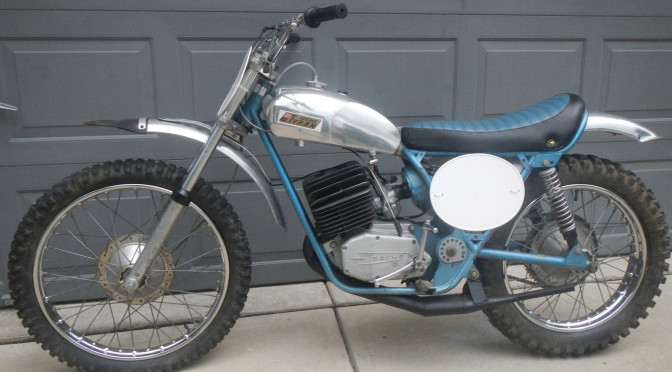
TYRAN 125 MX
Racers from the early '70s might recognize this bike, but only if you were one of the hard-core guys. Not too many of the Tyran bikes made it to the track, as they cost around a grand, when all the great Japanese bikes were in the $700 range. They were also faster, shifted better, and were more reliable. It's no small wonder then that the Tryan is no longer with us.
Model, designed for trail enthusiasts, is available in two versions. Both are four-speed two-strokes: a 60cc, 150-pound, 5.5-hp model, and a 90cc 169-pounder that provides 8.5 hp. Other dimensions are the same. Wheelbase is 42 inches, ground clearance 7 3/4 inches, seat height 28 inches, peg height 9 inches. A Mikuni carb is standard, and fuel capacity is 2 1/2 gallons. The bike incorporates a double-loop frame, Ceriani-type suspension, 6-volt battery, mufflered exhaust. Tires are 2.50 x 17-inch front, 2.50 x 15-inch rear. Suggested retail price of the 90cc Raider Enduro is $389; for the 60cc model it's $325.
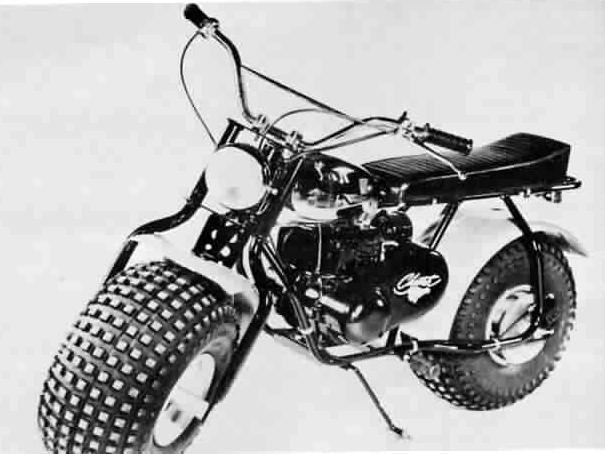
THE CHEETAHS - TAKE YOUR CHOICE
Actually, one of these things would be too many for my garage. The Cheetah was typical of the junk mini-bikes of the '70s, with a cheap tube frame, no suspension at all, and barbaric Tecumseh engines. Even worse, they were three wheelers! Gack!
Recreational Technology has designed a pair of Cheetahs, the 7-hp Model RT-250 (shown) and the 5-hp RT-200. They're powered by Tecumseh four-stroke 250cc and 200cc engines, respectively, with pull-cord starting and magneto ignition. Both utilize automatic torque-converter transmissions. Knobby tires are 21-inch diameter, 11 inches wide, on 8-inch rims, Inflation is 2 psi for off-road, 5 psi for hard surface use. Hand-operated Kelsey-Hayes brakes are caliper types on 8-inch diameter discs. Fuel capacity: 1 gallon (tank is chrome-plated on the RT-250). Reinforced 7/8-inch O.D. steel tubes, mig-welded, comprise the frame. Head- and taillight are standard on Cheetah 250. Wheelbase is 45 inches, ground clearance 10 inches, length 66 inches, width 30 inches. Weight: 150 pounds.
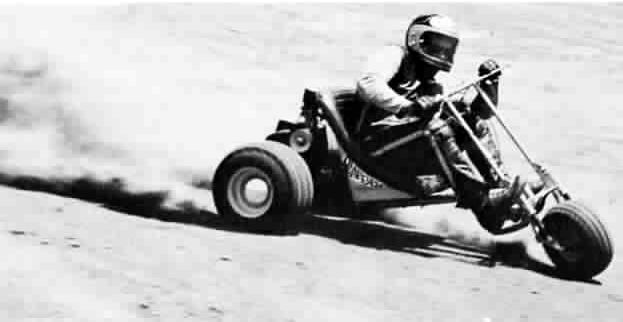
A.P.E. DUNECYCLE
Whoops, another goofy three wheeler, and this one made especially for the dunes. From the photo, it appears like it would be much more at home on a flat dirt field not too far from your truck. But back in 1972, they were proud of these beasts. Read on:
Starting a couple of years ago with one model, Allied Pacific Engineered Products now offer six race-proven Dunecycles, with horsepower ratings that range from 5 to 14. The three-wheeled vehicles, first introduced by A.P.E., started a whole new form of competition, and the firm's machines have continued their superiority - both in organized racing and off-road pleasure riding. Not a motorcycle, not a dune buggy, they're in a unique category that appeals to people with leanings toward either two or four wheels. Space limitations preclude listing of all models and complete specifications. For example, you can get them with Briggs & Stratton, Tecumseh or McCulloch engines; lights are available on some but not on others; tire sizes vary as do ground clearances; three models have front suspension and three don't, etc.
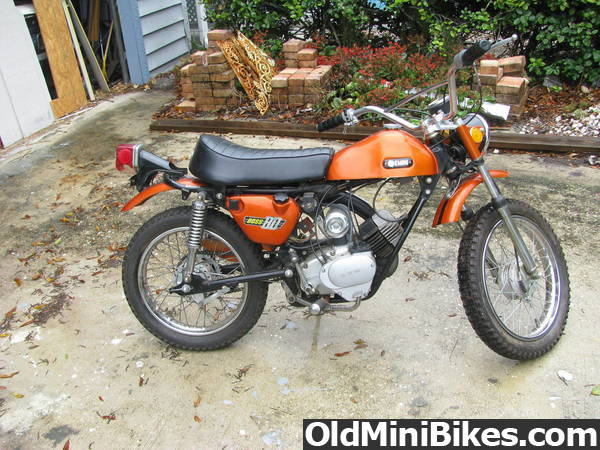
GEMINI BOSS 80
In the late '60s, the folks in the Orient saw that a whole bunch of American manufacturers were building mini bikes and making money, so they decided to jump into the business. After all, they were supplying engines and frames to the US, so why not a whole bike? However, to cover their butts, they also continued to sell the bikes without engines, frames alone, or just engines. Here's what they had to say about the Gemini:
San Tong has jumped into the two-wheeled field with a pair of Gemini mini-bikes (50cc and 80cc) and their larger Gemini Boss 80 mini-cycle (shown). This machine puts out 8.5 hp at 7000 rpm from its two-stroke, single-cylinder, rotary valve engine, has oil injection and four-speed transmission. It utilizes magneto ignition and telescopic front forks. Tuned exhaust system, lights and speedo are standard. Wheelbase is 46 inches, ground clearance 7 inches, seat height 30.2 inches. Tires front and rear are 2.50 x 15-inch, with optional 2.25 x 17 front. In addition to their Gemini bike line, the firm also supplies frames, sans engines, for mini-bikes.

PANTHER 175 BLACK SHADOW
When this bike first came out, half of the guys on my magazine staff were very, very pissed off that the name Black Shadow was used on a real piece of crap from Taiwan that was a dead ringer for an old Yamaha CT-1:
PURPOSE: Dual-purpose
PRICE: N/A
DISPLACEMENT: 175cc
ENGINE TYPE: Two-stroke single
LUBRICATION: Oil injection
IGNITION: Mag. flywheel
TRANSMISSION: 5-speed, left side shift
CLAIMED HORSEPOWER: 17 @ 7500 rpm
CLAIMED WEIGHT: 210 pounds
WHEELBASE: 51 inches
GROUND CLEARANCE: 10 inches
FRAME: Mild steel tubular
FRONT SUSPENSION: Telescopic forks
REAR SUSPENSION: Hydraulic shocks
FRONT TIRE: 3.25x19 knobby
REAR TIRE: 3.50x18 knobby
WHEELS: Steel
FUEL CAPACITY: 2.5 gallons
INSTRUMENTATION: Speedo. lights
COUNTRY OF MANUFACTURE: Taiwan
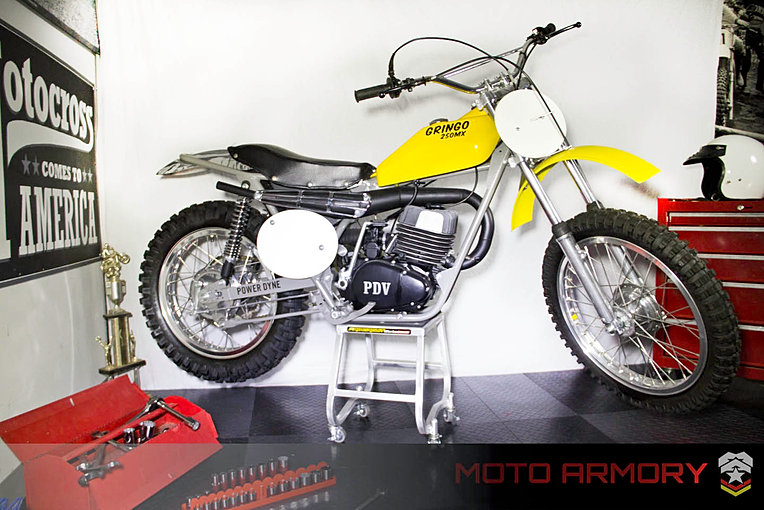
POWER DYNE - GRINGO 300/250
Another rip-off copy of the early '70s Yamaha MXers, the Power Dyne bikes even fielded a team in the National series, but soon ran out of money. The bikes were fast but unproven, and since they were highly modified (higher compression, big ports, etc.) they had more than their share of problems. Also, they claimed to be built in the US, but were reportedly built in Taiwan.
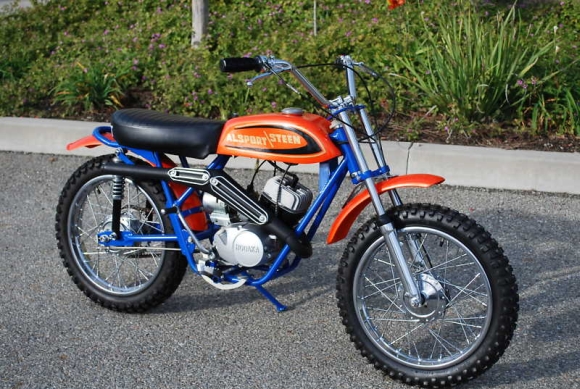
ALSPORT-STEEN X-100
This bike was actually popular for a while, then the company got sold and the leadership floundered. Effectively, progress stopped on the bikes while the Japanese came in with better and better products. By 1973, the Steen was history.
*Taken from superhunky.com
So I gathered up a bunch of them and figured I'd share them with you. As long as you're looking at these weird old bikes, take a casual test and see how many you recognize. If you get about half, that means you've been in the sport a long time, and qualify as a "dirt bike historian" yourself.
Have fun!

EL GATO ALL-FAMILY MIDI-CYCLE
An odd-looking little bike, El Gato (Spanish for "the Cat") claimed it was not a mini-bike, but a midi-bike, whatever that is. Like many bikes of the very early '70s, it used a Fuji engine, the fore-runner of the Hodaka. Here's what the company had to say about El Gato in their advertising literature:
The Muskin Corp. is introducing El Gato, a thoroughly tested all-family midi-cycle. Powered by an 80cc Fuji two-stroke, single-cylinder engine, the bike delivers 6.6 hp, has a four-speed, constant-mesh transmission and curb weight of 125 pounds. Well balanced on a 44-inch wheelbase, El Gato's overall length is 67 inches with seat height of 27 inches. The 3.00 x 16 knobby tires give maximum traction. The machine's seat-tank combination is finished in chrome yellow. Leading link front and swing arm rear suspension, front and rear internal expanding 105mm brakes, noise emission-approved spark arrester exhaust, flexible fenders and folding footpegs complete the package.

FANTIC CABALLERO 125RC
This neat small-bore enduro bike was powered by an Italian Minarelli engine and did quite well in European events. It saw some action in the early 1980's and a small number were sold in Europe.
Engine: Single-cylinder two-stroke, with piston-port induction
Capacity: 124cc (55.2 x 52mm)
Compression ratio: 14:1
Carburetion: 32mm Dell Orto with enrichening circuit for cold starting, breathing through oil-soaked foam filter
Claimed maximum power: 26bhp at 10,500rpm
Lubrication: P11 Goldfire at 40:1
Transmission: Primary drive by gears to six-speed gearbox. Wet clutch
Electrical equipment: 55-watt Motoplat generator with pointless ignition and 6-volt DC lighting
Fuel capacity: 8 litres (1.75 imp gal) (including reserve)
Suspension: Marzocchi leading axle front forks giving l0 inches of travel.
Twin damper swinging arm controlled by Sachs Hydracross units giving 11 inches of travel at the rear wheel
Frame: Full duplex
Tires: 3.00 x 21 in. front; 4.50 x l8in rear, both Metzeler motocross/enduro
Brakes: 6 inch s.l.s. by Grimeca front and rear
Wheelbase: 58in
Ground clearance: 12 in.
Saddle height: 35 in.
Claimed dry weight: 209 lbs.


BENELLI MIDI-SIDEHACK
A whole slew of mini bikes came out of Italy, but this one might just be the most bizarre. For some reason, it never caught on with anyone. Here's what Cosmo Motors, the distributors, had to say about this ... thing! Cosmopolitan Motors has made available the world's first "midi-sidecar," powered by the 65cc four-speed Dynamo series of midi-bikes. The sidecar features a 10-inch steel wheel and knobby tire, stainless steel fender, plush velour upholstered seat, leg cowling and a hand rail. Though firmly affixed to the Dynamo frame, the sidecar can be easily removed for servicing or solo riding.


MOTO-GORI TR250
The Austrian engine builder, Rotax, sold motors to a whole bunch of companies who made just a frame, bought all the other components, and slapped their name on the tank. This one was built in 1980.
Engine: SWM/Rotax single-cylinder two-stroke with disc-valve induction
Capacity: 248.23cc (72 x 61mm)
Compression ratio: 14:1
Claimed power: 38 bhp at 8500rpm
Carburetion: 32mm Dell Orto
Foam filter
Transmission: Five-speed with ratios to rider's choice.
Primary kickstarting with wet plate clutch
Ignition: Motoplat CDI with 55W generator. 6V DC lighting system
Fuel capacity: 12.7 litres (2.8 imp gal)
Frame: Single backbone with duplex engine cradle and twin shock
swinging arm
Tires: 3.00 x 2lin front; 4.50 x l8in rear. Metzeler motocross/enduro
Suspension: Samfis front forks with 12.4in of travel. Rear, Bitubo
dampers with external reservoir ... 11.8 in of travel
Brakes: Front, Grimeca 5 in; Rear, fully floating Grimeca, 5 in
Wheelbase: 50.2 in
Saddle height: 36.4 in
Ground clearance: l4 in
Dry weight: 224 1bs


SPEEDWAY SUPER SPYDER
This tiny and spindly-looking little bike came with a whopping 125 cc Sachs engine, which made for a lot of power in not much of a chassis. Still, the makers bragged up it highly in their 1970's ads:
On the trail, leave the others looking at the tailpipe of your Super Spyder. If your bag is winning, go with the name that consistently wins -- Speedway. Our bag is making top performance machines. To prove it, check out the "maximum mini" - the Speedway Super Spyder. Its 125cc Sachs engine, kick start, and five- speed synchronized foot-operated gears make you feel you're riding one of the big bikes.
All things considered, I never heard of a Super Spyder winning any race, anywhere. By the way, Speedway also offered other models with fancy names, like the Scorpion and the more-than-aptly-named Widowmaker.

Not too sure if you like boys or girls, or both? Then this Bi-Car should fit the bill nicely. Here's more info from the makers in the year 1972:
Traditionalists may flinch, but here's a totally new concept in two-wheeled touring vehicles. And adventurous souls just might find that "something different" they're looking for in the Bi-Car. Eight years of research and development have gone into the Bi-Car, so it's no spur-of-the-moment idea. Bell Vehicle, Inc., IS serious about the project, and has even more expansive plans for the future. The vehicle seats two passengers in tandem and utilizes standard motorcycle controls. At lower speeds and when stopping, the Bi-Car features a retractable landing gear that comes down to stabilize the machine. In addition to a sturdy, close-fitting shell, an optional canopy offers protection from dust, rain, noise and wind. Shown is the Saturn 500 model; it's 9 feet, 10 inches long, 33 inches wide and weighs 470 pounds. Powered by a 500cc, 60-hp engine that gets up to 40 mpg, Saturn models are in production and sell from $1590 up.


SPORTY SNOWCO TRI-SCAT
What a sad name for this 1972 three-wheeler. "Scat?" Isn't that slang for ... well ... never mind. Three ways to "dump" it? Anyway, the makers were proud enough of this no-suspension device to write some glowing copy:
The Snowco line of three-wheel vehicles offers utility as well as sport. And a front ski attachment which replaces the front wheel permits year-around use. Sportiest is the Tri-Scat with metalflake fiberglass body (shown), leather-type bucket seat, and low-bar, low-pressure ATV tires. It's available with 5-hp or 7-hp engine, and the 7-hp model comes equipped with standard head lamp and roll bar. The 7-hp Tri-Scat is also available in a deluxe model with 12-V key starter, head- and taillights, chrome front fork, roll bar and hubcaps. More utilitarian is the Nomad, also available with 5-hp or 7-hp engine, and equipped with wide, low-pressure knobby tires. Headlight and roll bar are standard on the 7-hp model. Addition of an optional cargo carrier makes the machine a utility vehicle for hunters, fishermen, farmers and many other users. The "baby" of the line is the 2 1/2-hp Mini-Scat, produced especially for youngsters, but far from a toy.


BENELLI BANSHEE
Yet another midi-cycle from Benelli. I'm still puzzled as to that midi-cycle name that was used only for a few years in the '70s. Looks pretty much like a mini-cycle to me. Either way, this was their enduro model and among other claims, they figured it was ready for the roughest terrain:
Benelli's new midi-cycle is styled after their well known Mini-Enduro. The Banshee has an all-new 90cc, five-speed two-stroke engine. Pirelli moto-cross tires (2.75 x 15") and enduro suspension smooth out the toughest terrain. Full electrics, battery, and a 44-inch wheelbase make the Banshee street-legal. Other features include an upswept exhaust, skid plate, Dell'Orto concentric carburetor, radial cylinder head finning, and performance that will embarrass many 125's.

Want to build your own ill-handling, no-suspension mini bike? Well, you could in 1972, if you coughed up a few hundred bucks. Here's how:
ALL-TERRAIN TRAIL BIKE KIT - Heald, Inc., is now marketing a new Trail Bronc, model VT-3. Company officials state that the VT-3 has been improved in performance, reliability and riding comfort over previous models. Powered by a 172cc Tecumseh engine, the new Trail Bronc utilizes a sensitive torque converter transmission and heavy-duty No. 40 chain in the final drive. A big 8 ? inch wide rear tire and 6 1/2-inch wide front tire provide the traction and stability needed on the trail. Their low pressure design coupled with the telescoping front shocks, damped coil spring rear shocks and large - padded seat smooth out the rough spots encountered in trail riding. The 8-inch ground clearance and engine skidpan enable the bike to go over almost any obstacle. Full steel fenders both front and rear (decorated with a sporty racing stripe) serve to keep mud and dirt off both bike and rider. There are just two simple controls, a hand-operated brake lever and safe spring return twistgrip throttle. A stop button is also mounted on the chrome plated handlebars. The handlebars telescope down for easier transport and storage. The bike can be ordered with alternator engine for powering the optional road approved lighting accessory. A front ski is also available so the machine can be used the year around. This rugged bike is ideal for hunting, fishing, camping, farm and ranch, work or play. The Trail Bronc comes in money-saving, easy-to-assemble kit form.

CHAPARRAL "FAMILYWEIGHT" MINI-CYCLES
What happens when a '70s snowmobile company wants to get in on the dirt bike boom? Well, they build a carbon-copy of just about every other below-average mini-cycle ever made in that time frame. But they seemed proud of their effort, as the copy below illustrates:
Chaparral Industries, fastest growing major snowmobile company in the country, has recently added mini-cycles to its product line. The bikes will be available in three models: the Bullet ST80 (shown), the Bullet T80, and the Bullet T172. Built primarily for trail riding, the ST80 and T80 are four-speed bikes powered by a two-stroke, 80cc Fuji engine that pumps out 7.5 hp at 6800 rpm. The T172 has a 172cc Tecumseh four-stroke powerplant and torque-converter for shift-free riding. Top-of-the-line ST80 weighs 125 pounds, has hydraulic front suspension with rear coil springs. On this model, lights, horn and speedo package are standard. Trail-ready T80 version is stripped for action, has torque-tuned exhaust with spark arrester.

RAIDER ENDURO
Priced any mini bikes lately? Chances are you're not going to find brand new bikes in the $300 range, are you? But, back in the early '70s, this was just about the average price. Here's another one that never caught on, in spite of the low retail price.

TYRAN 125 MX
Racers from the early '70s might recognize this bike, but only if you were one of the hard-core guys. Not too many of the Tyran bikes made it to the track, as they cost around a grand, when all the great Japanese bikes were in the $700 range. They were also faster, shifted better, and were more reliable. It's no small wonder then that the Tryan is no longer with us.
Model, designed for trail enthusiasts, is available in two versions. Both are four-speed two-strokes: a 60cc, 150-pound, 5.5-hp model, and a 90cc 169-pounder that provides 8.5 hp. Other dimensions are the same. Wheelbase is 42 inches, ground clearance 7 3/4 inches, seat height 28 inches, peg height 9 inches. A Mikuni carb is standard, and fuel capacity is 2 1/2 gallons. The bike incorporates a double-loop frame, Ceriani-type suspension, 6-volt battery, mufflered exhaust. Tires are 2.50 x 17-inch front, 2.50 x 15-inch rear. Suggested retail price of the 90cc Raider Enduro is $389; for the 60cc model it's $325.

THE CHEETAHS - TAKE YOUR CHOICE
Actually, one of these things would be too many for my garage. The Cheetah was typical of the junk mini-bikes of the '70s, with a cheap tube frame, no suspension at all, and barbaric Tecumseh engines. Even worse, they were three wheelers! Gack!
Recreational Technology has designed a pair of Cheetahs, the 7-hp Model RT-250 (shown) and the 5-hp RT-200. They're powered by Tecumseh four-stroke 250cc and 200cc engines, respectively, with pull-cord starting and magneto ignition. Both utilize automatic torque-converter transmissions. Knobby tires are 21-inch diameter, 11 inches wide, on 8-inch rims, Inflation is 2 psi for off-road, 5 psi for hard surface use. Hand-operated Kelsey-Hayes brakes are caliper types on 8-inch diameter discs. Fuel capacity: 1 gallon (tank is chrome-plated on the RT-250). Reinforced 7/8-inch O.D. steel tubes, mig-welded, comprise the frame. Head- and taillight are standard on Cheetah 250. Wheelbase is 45 inches, ground clearance 10 inches, length 66 inches, width 30 inches. Weight: 150 pounds.

A.P.E. DUNECYCLE
Whoops, another goofy three wheeler, and this one made especially for the dunes. From the photo, it appears like it would be much more at home on a flat dirt field not too far from your truck. But back in 1972, they were proud of these beasts. Read on:
Starting a couple of years ago with one model, Allied Pacific Engineered Products now offer six race-proven Dunecycles, with horsepower ratings that range from 5 to 14. The three-wheeled vehicles, first introduced by A.P.E., started a whole new form of competition, and the firm's machines have continued their superiority - both in organized racing and off-road pleasure riding. Not a motorcycle, not a dune buggy, they're in a unique category that appeals to people with leanings toward either two or four wheels. Space limitations preclude listing of all models and complete specifications. For example, you can get them with Briggs & Stratton, Tecumseh or McCulloch engines; lights are available on some but not on others; tire sizes vary as do ground clearances; three models have front suspension and three don't, etc.

GEMINI BOSS 80
In the late '60s, the folks in the Orient saw that a whole bunch of American manufacturers were building mini bikes and making money, so they decided to jump into the business. After all, they were supplying engines and frames to the US, so why not a whole bike? However, to cover their butts, they also continued to sell the bikes without engines, frames alone, or just engines. Here's what they had to say about the Gemini:
San Tong has jumped into the two-wheeled field with a pair of Gemini mini-bikes (50cc and 80cc) and their larger Gemini Boss 80 mini-cycle (shown). This machine puts out 8.5 hp at 7000 rpm from its two-stroke, single-cylinder, rotary valve engine, has oil injection and four-speed transmission. It utilizes magneto ignition and telescopic front forks. Tuned exhaust system, lights and speedo are standard. Wheelbase is 46 inches, ground clearance 7 inches, seat height 30.2 inches. Tires front and rear are 2.50 x 15-inch, with optional 2.25 x 17 front. In addition to their Gemini bike line, the firm also supplies frames, sans engines, for mini-bikes.

PANTHER 175 BLACK SHADOW
When this bike first came out, half of the guys on my magazine staff were very, very pissed off that the name Black Shadow was used on a real piece of crap from Taiwan that was a dead ringer for an old Yamaha CT-1:
PURPOSE: Dual-purpose
PRICE: N/A
DISPLACEMENT: 175cc
ENGINE TYPE: Two-stroke single
LUBRICATION: Oil injection
IGNITION: Mag. flywheel
TRANSMISSION: 5-speed, left side shift
CLAIMED HORSEPOWER: 17 @ 7500 rpm
CLAIMED WEIGHT: 210 pounds
WHEELBASE: 51 inches
GROUND CLEARANCE: 10 inches
FRAME: Mild steel tubular
FRONT SUSPENSION: Telescopic forks
REAR SUSPENSION: Hydraulic shocks
FRONT TIRE: 3.25x19 knobby
REAR TIRE: 3.50x18 knobby
WHEELS: Steel
FUEL CAPACITY: 2.5 gallons
INSTRUMENTATION: Speedo. lights
COUNTRY OF MANUFACTURE: Taiwan
POWER DYNE - GRINGO 300/250
Another rip-off copy of the early '70s Yamaha MXers, the Power Dyne bikes even fielded a team in the National series, but soon ran out of money. The bikes were fast but unproven, and since they were highly modified (higher compression, big ports, etc.) they had more than their share of problems. Also, they claimed to be built in the US, but were reportedly built in Taiwan.

ALSPORT-STEEN X-100
This bike was actually popular for a while, then the company got sold and the leadership floundered. Effectively, progress stopped on the bikes while the Japanese came in with better and better products. By 1973, the Steen was history.
*Taken from superhunky.com




